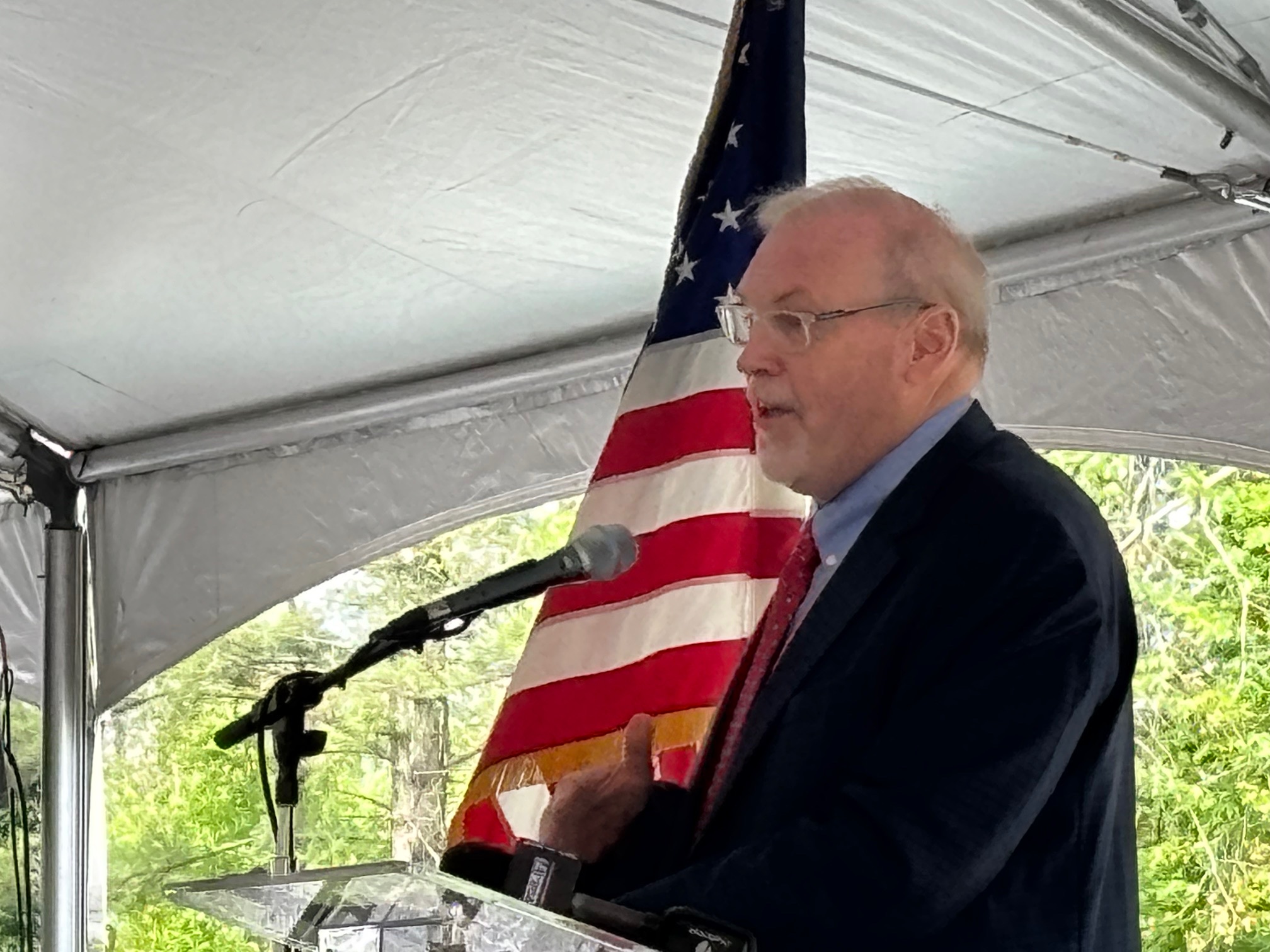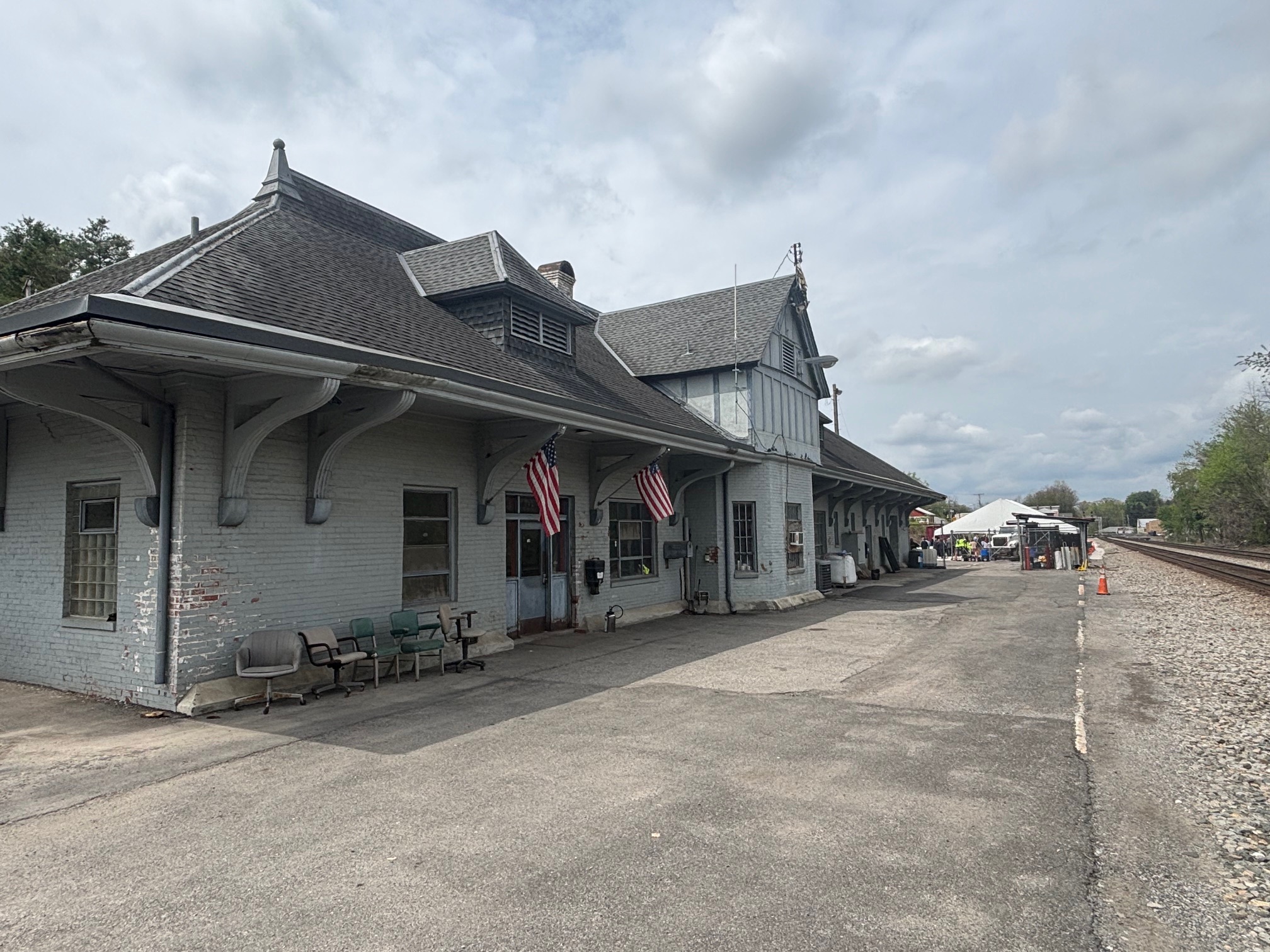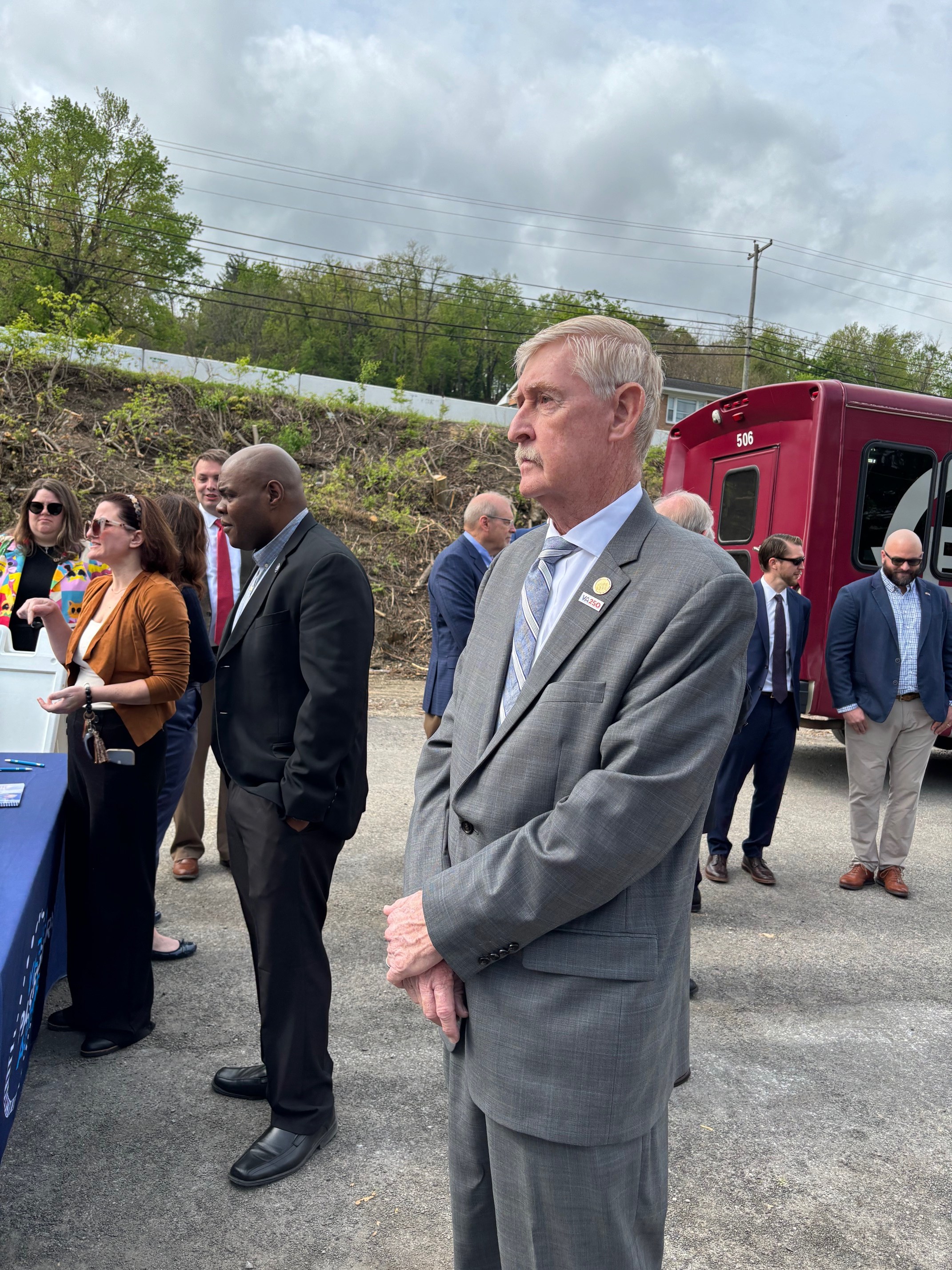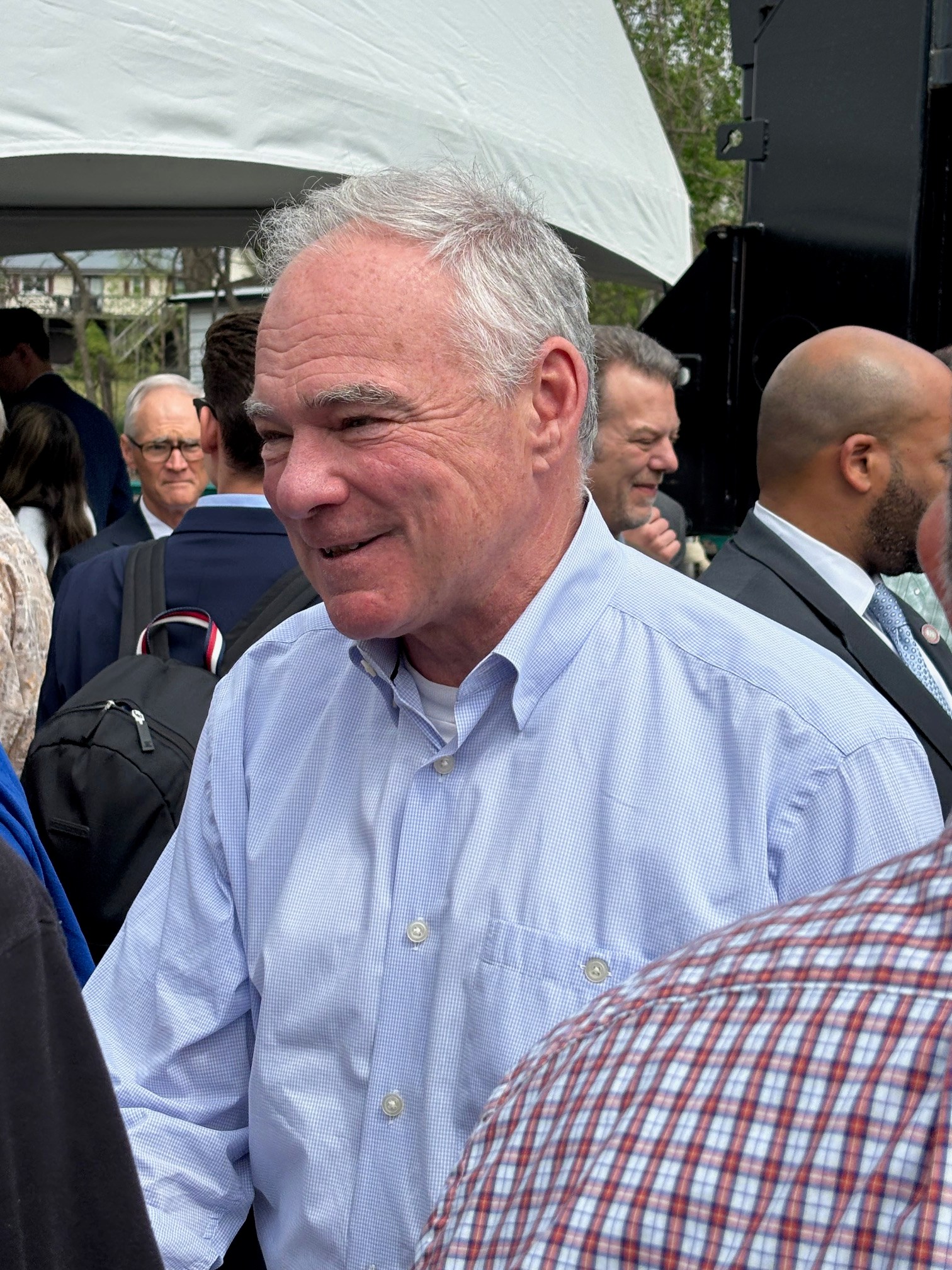With Gov. Glenn Youngkin front and center, sporting a hardhat and bright yellow construction vest, the most dignified of a tent full of dignitaries tossed a golden shovel full of ceremonial dirt on Thursday morning in front of the future railway platform in front of Christiansburg’s Cambria station.
For the many advocates of expanded rail service to the New River Valley, it was a moment some had longed to see ever since the last passenger train headed out of town limits more than four decades ago.

For Youngkin and the other guests invited to celebrate the moment — including Sen. Tim Kaine, D-Va.; Rep. Morgan Griffith, R-Salem; Del. Chris Obenshain, R-Blacksburg; state Secretary of Transportation Shep Miller; and Virginia Passenger Rail Authority executive director DJ Stadtler — Thursday represented another step toward reestablishing the rails as a viable source of travel, as well as an economic driver in Southwest Virginia and beyond.
“I’m excited to be here today,” Stadtler told a pleased audience. “I’ll be more excited to be here in 24 months … or less to take a train north.”
Those words gave the gathering that was already energized something else to get excited about. The estimated timetable for the first train coming out of Christiansburg, prior to Stadtler’s comments on Thursday, was August 2027, about 27 months away.
Christiansburg Mayor Michael Barber, who had been leading the charge for passenger service to return in his town since he assumed his current position in 2014, remembers boarding the train at the Cambria station before the service was discontinued in 1979, and said his next train trip will be in 2027 when Cambria is back on the line.
The governor’s office estimated the cost of the New River Valley project to be $264.5 million, including construction of the station platform, renovation of the train station, rail upgrades and an Amtrak layover facility in Radford. 
Barber is looking forward to the renovation of the Cambria train station, which opened in 1906. He said some pictures of what the interior looked like in the 1950s and ’60s have surfaced and hopes it will keep those qualities when it reopens.
“I think it should be the way it was,” he said. “We don’t need to build monuments to architects. We need to put that money into the functioning end results.”
Griffith was emotional when he spoke about the man he credited with always reminding him of the importance of an NRV rail stop: Wally Nelson, his college roommate at Emory & Henry and a Blacksburg resident who died in 2022.
“He was a big part of this,” Griffith said. “He wasn’t alone … but he did get me involved and I will always be appreciative because he was right.”
The push for New River Valley train service gradually increased beginning in 2009, when Amtrak added daily service between Lynchburg and Washington, D.C., on its Northeast Regional line and continued when service expanded to Roanoke in 2017. Total ridership on Amtrak’s Northeast Regional line between Roanoke and Washington was 343,585 in 2024. And the first two months of 2025 both broke all-time records, with 27,130 riders in January and another 23,427 in February.
So, next stop, Bristol?
“Passenger rail service in the commonwealth of Virginia is critical,” Youngkin said. “Just as we heard it was critical to connect Norfolk and it’s critical to connect Richmond to Petersburg and and it’s critical to connect Washington to Roanoke — and it’s critical to go through Christiansburg on the way to Bristol.”
Del. Terry Austin, R-Botetourt County and the senior Republican on the House transportation committee, said that while he had always been an advocate of improved transportation options in Southwest Virginia, he became a believer in rail service when he saw the success of the Amtrak service out of Roanoke.

“At first, I didn’t necessarily understand or agree with [rail solution advocates], but I do now,” Austin said. “We’ve got to work collaboratively with rail and surface transportation on Interstate 81 to help fix our problems here.”
The Christiansburg event wrapped up a satisfying week for the VPRA and its partners interested in maintaining the momentum of passenger rail expansion in Virginia.
Earlier in the week, the Federal Railroad Administration gave its final approval of a $729 million grant to cover an inflation-generated shortfall so the VPRA could continue with its $2.3 billion Long Bridge Project. When finished, two additional tracks will double rail crossing options over the Potomac River between Arlington and Washington. The VPRA says the two CSX-owned tracks operate at 98% capacity during peak periods, which leads to gridlock between passenger and freight lines.
“There have been a lot of moving pieces and we have had great support from all around us making sure they are in the right place at the right time,” said Stadtler, who has led the VPRA since its inception in 2021. “Look, these projects are complex — this one’s complex, the Long Bridge is complex. … That’s why we’re thrilled to be able to move forward today [in Christiansburg] and actually start construction.”
Stadtler set aside his concerns about the Beltway for a day to focus on the New River Valley project, which had overcome sizable odds in the past year to stay on line.
In spring 2021, Virginia reached an agreement with Norfolk Southern to bring passenger rail to the New River Valley and increase service from Roanoke to the Northeast corridor. However, it was discovered in early 2024 that the original route, which called for a new passenger station to be built near the New River Valley Mall and for upgrades to a mile-long tunnel built in the early 20th century, would be too expensive to pursue.
The project was revived later in the year when an agreement between VPRA and Norfolk Southern moved the passenger line over to the railroad’s main line. This not only reduced the estimated costs by at least $100 million, it also reduced the amount of work that would be needed in the future to further Northeast Regional service to Radford, Bristol and beyond.
Kaine, who said he first started hearing from rail enthusiasts when he was still mayor of Richmond and running for lieutenant governor in 2001, compared the progress of passenger rail in Virginia to the children’s book “The Little Engine That Could.” While everyone is now saying “I knew I could” when it comes to the Roanoke to Christiansburg expansion, he said it will take bipartisan efforts at the national level for progress to continue.
“But when the project is right, then it’s going to happen,” Kaine said. “I will also say that this is made possible by funding in the infrastructure bill that we did in November of 2021 — the first year of the Biden administration.”

Kaine added that while the credit for the expansion already done in the Virginia rail system was an intrastate effort among public, private, state and local officials, there will be additional challenges getting to Bristol, an endeavor that is still in its infant stages.
The good news is that the shift of the New River Valley addition to Norfolk Southern’s main line means that much of the needed infrastructure is already in place. But unlike the work done up to now, getting to Bristol will mean interstate cooperation, specifically with Tennessee.
“We will need excitement and cooperation from our Tennessee colleagues,” Kaine said. “I don’t think there’s a scenario where Amtrak will go to Bristol and just stop in Bristol. They will want to go on to Chattanooga and maybe to Atlanta.”
Kaine added that while the Trump administration has allowed funding to continue with the current rail projects in Virginia, he believes it will be necessary for the state’s congressional members, as well as he and Sen. Mark Warner, a fellow Democrat, to continue to advocate for future projects, including extending to Bristol.
“There are some worries about some of the projects — are they going to be paused by the current administration?” Kaine said. “But this was a bipartisan effort and this is an important economic development and quality of life investment in Southwest Virginia.
“So it needs to stay on track.”



